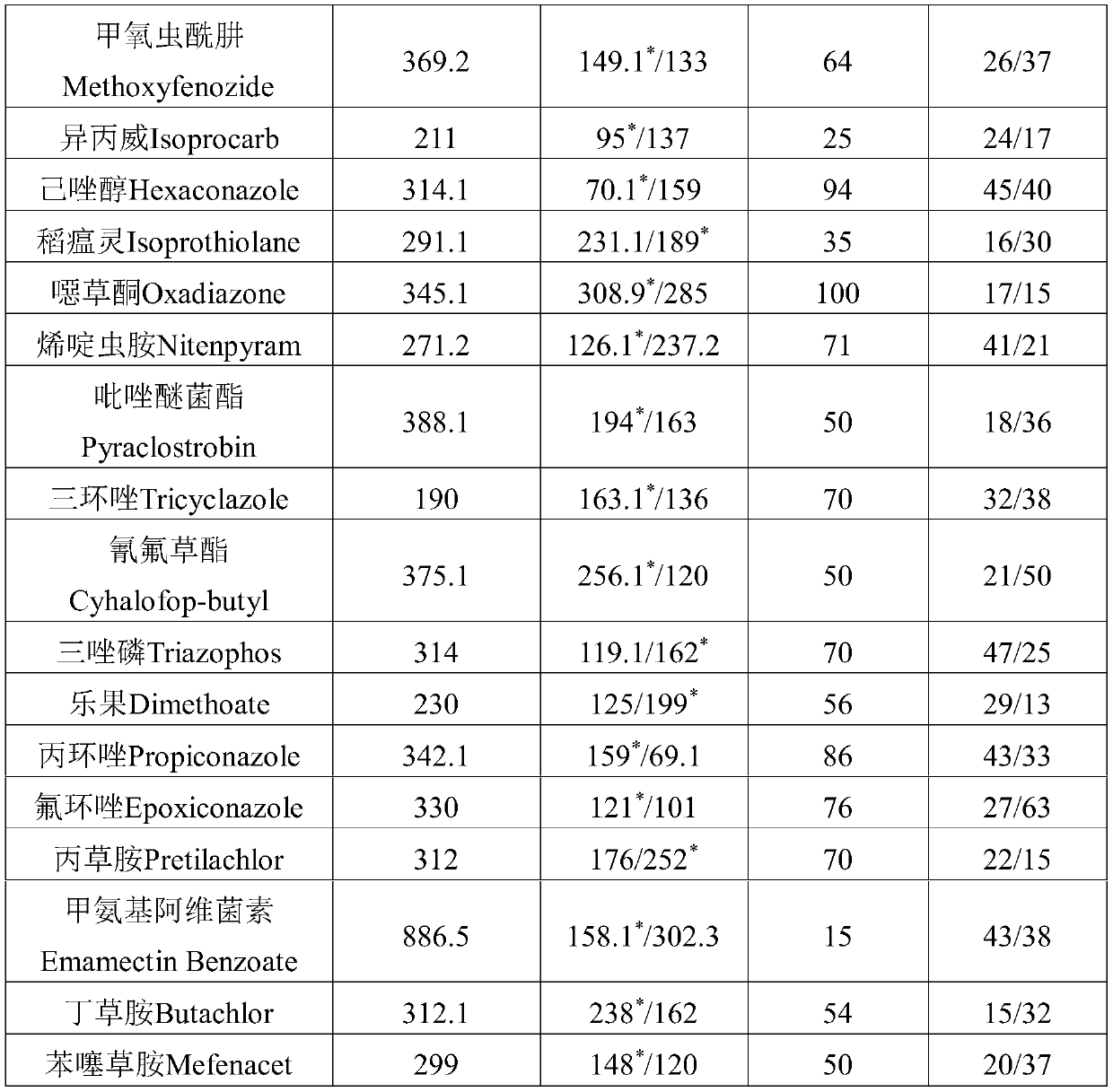Method for detecting pesticide residues in rice and rice stems
A technology for pesticide residues and detection methods, applied in measuring devices, instruments, scientific instruments, etc., can solve problems such as difficult simultaneous quantitative detection of rice
- Summary
- Abstract
- Description
- Claims
- Application Information
AI Technical Summary
Problems solved by technology
Method used
Image
Examples
Embodiment 1
[0113] Embodiment 1 methodological verification
[0114] 1 Materials and methods
[0115] 1.1 Materials and reagents
[0116] Rice samples were collected from the suburbs of Shanghai;
[0117] Pesticide standard samples were purchased from Shanghai Anpu Experimental Technology Co., Ltd., and the prepared concentration was 1000mg / L standard solution;
[0118] GCB adsorbent (graphitized carbon black) and PSA adsorbent (ethylenediamine-N-propylsilane) were purchased from Shanghai Anpu Experiment Technology Co., Ltd.;
[0119] Sodium chloride, anhydrous magnesium sulfate, sodium citrate and disodium citrate, analytically pure, purchased from Shanghai Anpu Experiment Technology Co., Ltd.;
[0120] Acetonitrile, methanol, formic acid, chromatographically pure, purchased from Tedia, USA;
[0121] Polytetrafluoroethylene (PTFE) (hydrophilic / hydrophobic) and 0.22 μm nylon filter membrane were purchased from Shanghai Anpu Experimental Technology Co., Ltd.;
[0122] Ultrapure water ...
Embodiment 2
[0183] By using QuEChERS-UPLC-MS / MS to detect 10 rice samples purchased from the market (purchased from the Shanghai Agricultural Products Central Wholesale Market), the results showed that the three pesticides acetamiprid, azoxystrobin and indoxacarb had samples detected respectively. Among them, the detected concentration of acetamiprid was 1.33 μg·kg -1 , the detection concentration of 1 sample of azoxystrobin was 1.10 μg·kg -1 , the detected concentrations of the two samples of indoxacarb were 2.21 and 10.46 μg·kg respectively -1 , no pesticides were detected in other samples; at the same time, the pesticide residues in 10 forage grasses with rice stalks as raw materials were screened, and the results showed that the detected concentrations of the two samples of Daobunling were 15.18 and 14.66 μg·kg respectively -1 , the detection concentration of 1 sample of indoxacarb was 17.25 μg·kg -1 , the detected concentrations of the two samples of pymetrozine were 9.58 and 17.73...
Embodiment 3
[0185] Take 3 parts of rice from a rice production base in Shanghai, and process it according to the following steps:
[0186] 1) Sample preparation
[0187] The paddy samples were dehulled, ground and pulverized in a high-speed pulverizer, and passed through a 40-mesh sieve.
[0188] 2) Extraction and purification
[0189] Extraction: Weigh 5.0g of rice evenly into a 50mL centrifuge tube, add 10mL of distilled water, vortex and mix well, at the same time add ceramic beads with a diameter of 4mm, add 10mL of acetonitrile, and vortex again for 30 seconds to mix. Add QuEChERS extraction reagent (anhydrous MgSO 4 5.5g, NaCl 1.5g, disodium citrate 0.5g and sodium citrate 1.0g), mix quickly, put in a shaker, shake at high speed for 10min, and then shake at 4000r·min -1 , Centrifuge at 4°C for 5 minutes and wait for purification.
[0190] Purification: Take 10 mL of the centrifuged supernatant, add purification reagent (PSA 0.1 g, anhydrous MgSO 4 0.6g). Shake at high speed fo...
PUM
| Property | Measurement | Unit |
|---|---|---|
| diameter | aaaaa | aaaaa |
Abstract
Description
Claims
Application Information
 Login to View More
Login to View More - R&D
- Intellectual Property
- Life Sciences
- Materials
- Tech Scout
- Unparalleled Data Quality
- Higher Quality Content
- 60% Fewer Hallucinations
Browse by: Latest US Patents, China's latest patents, Technical Efficacy Thesaurus, Application Domain, Technology Topic, Popular Technical Reports.
© 2025 PatSnap. All rights reserved.Legal|Privacy policy|Modern Slavery Act Transparency Statement|Sitemap|About US| Contact US: help@patsnap.com



